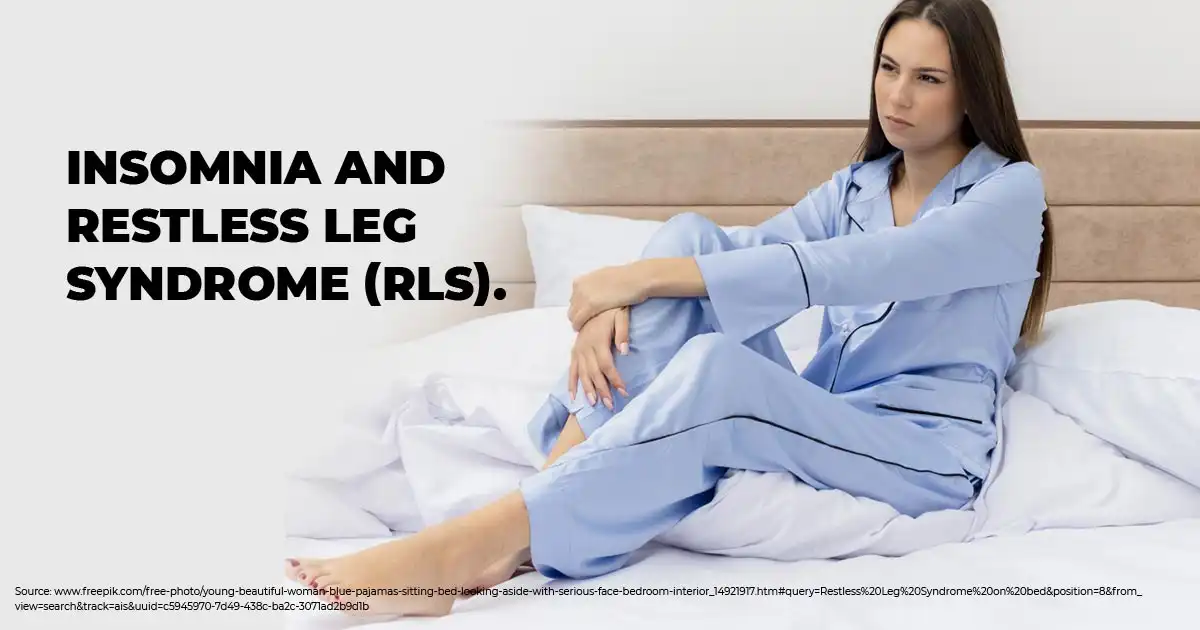Restless Leg Syndrome (RLS) and Its Interplay with Insomnia: Proven

Do you often find yourself restless in bed with an urge to move your legs and unable to sleep?
Approximately 7 to 10 percent of the U.S. population is believed to experience Restless Leg Syndrome (RLS), a condition that can manifest at any stage of life. The intricate relationship between Restless Leg Syndrome (RLS) and insomnia might hold the key to understanding these struggles. RLS, a condition characterized by irresistible urges to move your legs, is interrelated with insomnia, significantly impacting your ability to sleep.
This sleep and health blog unravels the interplay between insomnia and RLS, exploring symptoms, causes, risk factors, treatments, and practical tips to manage this sleep disorder. Join us to solve all the questions on RLS as we discuss new treatment avenues for improved sleep health.
How Is Restless Leg Syndrome (RLS) Related to Insomnia?
Restless Leg Syndrome (RLS) is closely interconnected with insomnia, with RLS symptoms significantly impacting one’s ability to fall asleep and maintain restful sleep.
What does restless leg syndrome feel like?
The manifestation of RLS symptoms, often occurring shortly after lying down at night, prompts individuals to engage in leg movements such as kicking, stretching, or massaging to alleviate discomfort.
Both genders can be affected, with a slightly higher prevalence observed in females. The impact of RLS tends to be more pronounced in individuals who are in the middle-aged or older demographic. As age advances, the frequency and duration of symptoms often increase, leading to a more significant impact on those affected.
The sleep disturbances associated with RLS contribute to difficulty falling and staying asleep, leading to fatigue and daytime sleepiness. Sleep deficiency resulting from RLS is linked to other health problems like anxiety, depression, obesity, and heart disease. Individuals with RLS often seek medical care primarily due to concerns about their sleep.
Research on RLS and Sleep
Johns Hopkins University School of Medicine uncovered that 88% of individuals with RLS experienced sleep-related symptoms. This research explored the neurobiological aspects of RLS and its impact on sleep.
Traditionally, RLS is often associated with a dysfunction in dopamine, a neurotransmitter crucial for smooth muscle activity and movement. Although effective in addressing the urge to move the legs, medications targeting dopamine levels do not significantly improve sleep.
Magnetic Resonance Imaging (MRI) is a procedure which helps to examine the brains of individuals with RLS. Their brains showed high levels of glutamate, which is a neurotransmitter associated with arousal from sleep. The researchers discovered a correlation between elevated glutamate levels in the thalamus (the brain region regulating consciousness, sleep, and alertness) and decreased sleep duration in individuals with RLS. Individuals without RLS did not exhibit elevated levels of glutamate.
The study’s findings suggest a potential shift in the understanding and treatment of RLS. If confirmed, these results may lead to a reevaluation of treatment approaches, considering medications that reduce glutamate levels. The hyper-arousal induced by excess glutamate may explain the lack of daytime sleepiness in RLS patients, despite their insufficient nighttime sleep.
The implications of this research extend beyond RLS, suggesting that understanding the neurobiology of arousal and sleep may have relevance for some forms of insomnia and difficulty sleeping. This novel insight into the role of glutamate in sleep disturbances associated with RLS can open up new possibilities for more targeted and effective treatments for this RLS and other related sleep disorders.
Causes of Restless Leg Syndrome (RLS)
Several medical conditions like damaged nerves causes Restless Leg Syndrome (RLS) symptoms to develop. However, for a significant number of individuals with RLS, the precise cause remains unknown.
Here are some contributing factors and conditions to Restless Leg Syndrome (RLS).
I. Medical Conditions
- Late-Stage Kidney Disease: Late-stage kidney disease holds a degree of association with RLS, and individuals undergoing dialysis may become more prone to experiencing RLS symptoms.
- Iron Deficiency: Insufficient levels of iron in the body contribute to RLS. Iron is a mineral which plays a crucial role in the production process of neurotransmitter dopamine. Thus, medical practitioners often prescribe iron as a supplement for restless leg syndrome.
- Neuropathy: RLS develops from certain neuropathic conditions and damages to the nervous system. Impairment in nerve functioning may contribute to the characteristic sensations experienced in RLS.
- Multiple Sclerosis: Some individuals with multiple sclerosis, have experienced RLS symptoms. Multiple sclerosis is a condition which affects the central nervous system and is an autoimmune disorder.
- Parkinson’s disease: There is an association between RLS and Parkinson’s disease, which involves disruptions in dopamine function similar to those seen in RLS.
II. Pregnancy & Restless Leg Syndrome
- RLS can occur temporarily during pregnancy, particularly during the 3rd trimester. Approximately 10% to 34% of women may develop RLS symptoms during pregnancy. How to get rid of restless leg syndrome while pregnant? Taking warm baths, massages, cool packs, exercising and a proper sleep routine can alleviate RLS symptoms. It is noteworthy that symptoms often diminish after delivery.
III. Genetic Component
- RLS may have a genetic basis, as evidenced by familial patterns. Between 40% and 90% of people with RLS at least one first-degree relative have the condition. Genetic studies have identified some specific genetic changes associated with an increased risk of RLS, suggesting a hereditary component.
In cases where RLS is secondary to another medical condition, addressing the underlying health issue may alleviate or improve RLS symptoms.
Symptoms of Restless Leg Syndrome (RLS)
Restless Leg Syndrome (RLS) exhibits a unique set of sensations that distinguish it from normal experiences. The symptoms associated with RLS can be challenging to articulate due to their distinct nature.
The American Academy of Sleep Medicine, outlines that individuals with RLS experience the underlying symptoms.
- Need to stretch the legs: Individuals with RLS often report a persistent urge to stretch their legs as a way to alleviate the discomfort. This need to stretch is a common response to the sensations associated with RLS.
- Discomfort: Individuals with RLS experience a general feeling of discomfort in the legs. The uneasy sensation may be mild or it can be a more intense discomfort that people may find as irritating or bothersome.
- Twitching: Individuals with RLS often describe a sensation of twitchiness in their legs. This may manifest as involuntary, small, rapid movements or a sense of restlessness within the leg muscles.
- Restlessness: The term “restless” aptly captures the overall feeling of unease and the compelling need to move the legs. This restlessness is particularly pronounced when one sits or lies down, hindering the ability to stay still.
- Legs move on their own: Some individuals with RLS claim that their legs seem to have a mind of their own. That they move their legs without conscious control. This autonomous feeling contributes to the challenge of managing the symptoms.
- Urge for movement: A key characteristic of RLS is a strong urge to move the legs. This urge is a compelling, involuntary need to engage in leg movements, which provides temporary relief from the discomfort.
All these symptoms collectively convey the subjective and varied nature of the sensations experienced by individuals with RLS. The symptoms not only make it difficult to articulate the exact nature of the discomfort but also underscore the disruptive impact of RLS on a person’s ability to find relief and attain peaceful sleep.
Risk Factors of Restless Leg Syndrome (RLS)
Certain risk factors act as triggers for developing or exacerbating the symptoms of RLS. Timely identification of these triggers and concrete understanding of these risk factors is crucial for both prevention and treatment.
Some triggers or risk factors associated with RLS are discussed below.
I. Sleep Disruption
- Addiction causing substances can adversely affect sleep routine when taken in excess dosage or too close to bedtime. Sleep disruptions, in turn, can exacerbate RLS symptoms, creating a cyclical relationship between RLS and sleep disturbances.
II. Substances
- Alcohol: Consumption of alcohol as a substance worsens RLS symptoms. It is advisable for individuals with RLS to moderate their alcohol intake, especially close to bedtime.
- Caffeine: Stimulants like caffeine, found in coffee, tea, and certain sodas, triggers RLS symptoms. Limiting caffeine intake, particularly in the evening, may help manage symptoms.
- Nicotine: Nicotine, present in tobacco products, causes an exacerbation of RLS symptoms. Smoking cessation efforts may be beneficial for individuals with RLS.
- Medications: Certain medications, including those used in treatment of allergies, cold, nausea, or other mental health issues, can contribute to or worsen RLS symptoms. It is essential for individuals to discuss their medications with healthcare professionals to identify potential factors which may contribute to RLS.
III. Sedentary Behavior
- Periods of inactivity or rest often trigger RLS symptoms in individuals. Prolonged sitting or lying down can provoke discomfort and the urge to move your legs.
It’s important to note that these factors may not be direct causes for RLS for everyone with the condition. Individuals with RLS may have varying sensitivities to these triggers, and the impact can differ from person to person.
Managing RLS often involves lifestyle modifications, including addressing these risk factors. Adopting a more active lifestyle, reducing the consumption of substances known to worsen symptoms, and maintaining good sleep hygiene are strategies that can contribute to symptom relief. Consulting with a healthcare professional is crucial for personalized advice and appropriate management of RLS symptoms. Let’s learn more about the effective measures for management of RLS.
Treatment For Restless Leg Syndrome (RLS)
The treatment of Restless Leg Syndrome (RLS) aims to achieve 2 primary goals: stabilizing symptoms and improving sleep consistency.
Both non-medicinal approaches and drug treatments are available to effectively manage RLS.
I. Restless Leg Syndrome – Non-Medicinal Approaches
- Lifestyle Modifications: Adopting a more active lifestyle, like incorporating regular exercise can help alleviate RLS symptoms. Further, try to avoid prolonged periods of inactivity.
- Sleep Hygiene: Establish healthy sleep habits and start with maintaining a consistent sleep routine. This and creating a peaceful sleep environment, can contribute to better sleep quality.
- Dietary Adjustments: Managing substance intake can play a role in reducing RLS symptoms. This includes moderating the consumption of alcohol, caffeine, and nicotine,.
- Iron Supplements: Restless Leg Syndrome and low iron levels in the body exist simultaneously. Therefore, medical practitioners recommend iron supplement in cases of individuals with iron deficiency. Addressing low iron levels can help improve RLS symptoms, as iron is essential for normal dopamine function.
II. Restless Leg Syndrome – Drug Treatments
- Dopaminergic Medications: Medical practitioners prescribe drugs affecting dopamine levels in the brain to alleviate RLS symptoms. These medications regulate the neurotransmitter dopamine, which aids in the development of RLS.
- Anticonvulsant Medications: Certain anticonvulsant drugs, such as gabapentin or pregabalin, have demonstrated effectiveness in managing RLS symptoms.
Medical practitioners choose a treatment plan that depends on the severity of symptoms, underlying causes, and individual response to interventions. A comprehensive approach to restless leg syndrome, the new cure plan combines lifestyle adjustments with targeted medications to achieve optimal results.
Individuals experiencing RLS symptoms should consult with healthcare professionals. This is to determine an ideal management plan targeting the condition and suiting specific needs or individual circumstances. A few home remedies for restless leg syndrome in females and males are all discussed below.
Home Remedies and Tips for Management – Restless Leg Syndrome & Sleep
Wondering how to stop Restless Leg Syndrome immediately when you are at home? Effective management of Restless Leg Syndrome (RLS) involves a combination of lifestyle adjustments and, medication for severe symptoms.
Here are some effective tips that can help promote Restless Leg Syndrome relief at home.
I. Tip 1: Maintain a Sleep Hygiene
- Maintain a Bedroom Environment: Create a sleep-conducive environment in the bedroom, promoting comfort and relaxation.
- Consistent Daily Routine: Establish a regular sleep schedule to support high-quality sleep and minimize disruptions to circadian rhythms.
- Avoid Alcohol and Caffeine: Steer clear of alcohol and caffeine, particularly close to bedtime. This is because these substances can exacerbate RLS symptoms.
II. Tip 2: Massage and Hot Baths
- Explore Relaxation Techniques: Massage and hot baths help to stimulate the legs and promote relaxation. Individuals may find these comforting in Restless Leg Syndrome as quick relief measures.
III. Tip 3: Pneumatic Pressure Therapy
- Consider Compression Devices: Pneumatic compression devices enhance blood flow by applying pressure to the legs. These devices have shown promise in improving RLS symptoms, quality of life, and fatigue. Daily use of these devices demonstrated positive outcomes in a research study.
IV. Tip 4: Routine Exercise
- Engage in Physical Activity: Regular exercise is beneficial for individuals with RLS. Physical activity helps counteract the effects of inactivity. A study found a significant reduction in symptom severity with a six-week exercise program.
In wrapping up our discussion on Insomnia and how its related to RLS, we’ve uncovered intriguing facts. Recent revelations, on the understanding of treating and managing RLS, mark a significant stride in future perspectives. Beyond individual struggles, this sleep disorder extends its influence with insomnia. With 7-10% of the U.S. population grappling with these challenges, our journey serves to unravel the secrets of RLS. This article acts as a professional guide to navigate the complexities on sleep health.
Disclaimer
The content presented is for informative purposes and should not be considered a replacement for professional guidance. It is not meant to diagnose any sleep or mental health conditions. Before making any alterations to your sleep habits, it is recommended to consult with a healthcare professional for personalized advice.







